By
Shubham Malu
DEPARTMENT OF CIVIL ENGINEERING N.D.MV.P.S’s K.B.T.C.O.E NASHIK
1.INTRODUCTION
The artificial recharge to ground water aims at augmentation of ground water reservoir by modifying the natural movement of surface water utilizing suitable civil construction techniques. Artificial recharge techniques normally address to following issues –
(i) To enhance the sustainable yield in areas where over-development has depleted the aquifer
(ii) Conservation and storage of excess surface water for future requirements, since these requirements often changes within a season or a period.
(iii) To improve the quality of existing ground water through dilution.
(iv) To remove bacteriological and other impurities from sewage and waste water so that water is suitable for re-use.
Thus, in most situation, artificial recharge projects not only serve as water conservation mechanism but also assist in overcoming problem associated with overdraft.The increasing demand for water has increased awareness towards the use of artificial recharge to augment ground water supplies. Stated simply, artificial recharge is a process by which excess surface-water is directed into the ground – either by spreading on the surface, by using recharge wells, or by altering natural conditions to increase infiltration – to replenish an aquifer. It refers to the movement of water through man-made systems from the surface of the earth to underground water-bearing strata where it may be stored for future use. Artificial recharge (sometimes called planned recharge) is a way to store water underground in times of water surplus to meet demand in times of shortage.
Some factors to consider for artificial recharge are :-
• Availability of waste water
• Quantity of source water available
• Quality of source water available
• Resultant water quality (after reactions with native water and aquifer materials)
• Clogging potential
• Underground storage space available
• Depth to underground storage space
• Transmission characteristics of the aquifer
• Applicable methods (injection or infiltration)
• Costs
1.1 IDENTIFICATION OF AREAS FOR RECHARGE
The first step in planning a recharge scheme is to demarcate the area of recharge. Such an area should, as far as possible, be a micro-watershed (2,000-4,000 ha) or a mini-watershed(40-50 ha). However, localized schemes can also be taken up for the benefit of a single hamlet or a village. In either case the demarcation of area should be based on the following broad criteria:
- Where ground water levels are declining due to over-exploitation
- Where substantial part of the aquifer has already been desaturated i.e. regeneration of\ water in wells and hand pumps is slow after some water has been drawn
- Where availability of water from wells and hand pumps is inadequate during the lean months
- Where ground water quality is poor and there is no alternative source of water
1.2 SOURCES OF WATER FOR RECHARGE
Before undertaking a recharge scheme, it is important to first assess the availability of adequate water for recharge. Following are the main sources, which need to be identified and assessed for adequacy:
- Precipitation (rainfall) over the demarcated area
- Large roof areas from where rainwater can be collected and diverted for recharge
- Canals from large reservoirs from which water can be made available for recharge
- Natural streams from which surplus water can be diverted for recharge, without violating the rights of other users
- Properly treated municipal and industrial waste waters. This water should be used only after ascertaining its quality
“In situ” precipitation is available at every location but may or may not be adequate for the recharge purposes. In such cases water from other sources may be transmitted to the recharge site. Assessment of the available sources of water would require consideration of the following factors:
- Available quantity of water
- Time for which the water would be available
- Quality of water and the pretreatment required
- Conveyance system required to bring the water to the recharge site
1.3 HYDRO-METEOROLOGICAL STUDIES
These studies are undertaken to understand the rainfall pattern and evaporation losses and there by to determine the amount of water that would be available from a given catchment and the size of storages to be built. The main factors to be considered are:
- Minimum annual rainfall during the previous 10 years
- Number of rainy spells in a rainy season and duration of each spell
- Amount of rainfall in each rainy spell
- Rainfall intensity (maximum) 3 hourly, 6 hourly etc. as may be relevant for a region.
As a general guide, the one, which causes significant runoff and local flooding, should be adopted.
This information/ data is usually readily available in District Statistical Reports published by the District Statistical Organisation. However, the most important source is the India Meteorological Department. For the purpose of rainwater harvesting only readily available secondary data is adequate. The alternative sources of this data are the reports of major, medium or minor irrigation projects, which have been recently completed in the region or are under construction or are planned.
1.3.1 HYDROGEOLOGICAL STUDIES
A detailed hydrogeological study of the project area and also the regional picture of hydrogeological setting is necessary to know precisely the promising locations for recharge and the type of structures to be built for the purpose. The aspects to be considered for a recharge scheme are:
Detailed information and maps showing
– Hydrogeological units demarcated on the basis of their water bearing capabilities at both shallow and deeper levels
– Ground water contours to determine the form of the water table and hydraulic connection of ground water with rivers, canals etc.
– Depth to water table (Maximum, Minimum and Mean)- Amplitude of water level fluctuations
– Piezometric head in deeper aquifers and their variation with time- Ground water potential of different hydrogeological units and the level of ground water development- Chemical quality of water in different aquifersThis information is usually available in district-wise ground water reports prepared by the Central Ground Water Board and/ or the State Ground Water Board.
1.3.2 GEOPHYSICAL STUDIES
These studies are expensive and time consuming and require high levels of skill and sophisticated equipment. These are, therefore, economically viable for large ground water development projects and are not suitable for small artificial recharge schemes at local/village level.
The main purpose of applying geophysical methods for the selection of appropriate site for artificial recharge studies is to assess the unknown sub-surface hydrogeological conditions economically, adequately and unambiguously. Generally the prime task is to compliment the exploratory programme. Mostly it is employed to narrow down the target zone, pinpoint the probable site for artificial recharge structure and its proper design.Nevertheless, the application of geophysical methods is to bring out a comparative picture of the sub-surface litho environment, surface manifestation of such structures and correlate them with the hydrogeological setting. Besides defining the sub-surface structure and lithology, itcan identify the brackish/ fresh ground water interface, contaminated zone (saline) and the area prone to seawater intrusion.
Using certain common geophysical methods, it is possible to model the
- Stratification of aquifer system and spatial variability of hydraulic conductivity of the characteristic zone, suitable for artificial recharge
- Negative or non-productive zones of low hydraulic conductivity in unsaturated and saturated zones
- Vertical hydraulic conductivity discontinuities, such as dyke and fault zone
- Moisture movement and infiltration capacity of the unsaturated zone
- Direction of ground water flow under natural/ artificial recharge processes
- Salinity ingress, trend and short duration depth salinity changes in the aquifers due to varied abstraction or recharge
The application of proper techniques, plan of survey and suitable instruments can yield better understandable results, but, of indirect nature.
1.4 QUALITY OF SOURCE WATER
Chemicals and Salts
Problems which arise as a result of recharge to ground water are mainly related to the quality of raw waters that are available for recharge and which generally require some sort of treatment before being used in recharge installations. They are also related to the changes in the soil structure and the biological phenomena, which take place when infiltration begins,thereby causing environmental concerns. The chemical and bacteriological analysis of source water and that of ground water is therefore essential.
Sediment Load
A major requirement for waters that are to be used in recharge projects is that they be silt free.
Silt may be defined as the content of undissolved solid matter, usually measured in mg/l, which settles in stagnant water or in flowing water with velocities, which do not exceed 0.1 m/hr.
PREVENTION OF CLOGGING OF SOIL PORES
This is one of the important considerations in planning an artificial recharge scheme. The usual methods to minimize the clogging are:
- Periodical removing of the mud-cake and dicing or scraping of the surface layer
- Installation of a filter on the surface, the permeability of which is lower than that of
the natural strata (the filter must be removed and renewed periodically)
- Addition of organic matter or chemicals to the uppermost layer
- Cultivation of certain plant-covers, notably certain kinds of grass
- Providing inverted filter consisting of fine sand, coarse sand and gravel at the bottom of infiltration pits/ trenches are very effective
Clogging by biological activity depends upon the mineralogical and organic composition of the water and basin floor and upon the grain-size and permeability of the floor. The only feasible method of treatment developed so far consists in thoroughly drying the ground under the basin.
2.0 METHODS OF ARTIFICIAL RECHARGE
These can be broadly classified as:
Spreading Method
– Spreading within channel
– Spreading stream water through a network of ditches and furrows
– Ponding over large area
(a) Along stream channel viz. Check Dams/ Nala Bunds
(b) Vast open terrain of a drainage basin viz. Percolation Tanks
(c) Modification of village tanks as recharge structures.
– Recharge Shafts
– Vertical Shafts
– Lateral Shafts
• Injection Wells
• Induced Recharge
• Improved Land and Watershed Management
– Contour Bunding
– Contour Trenching
– Bench Terracing
– Gully Plugging
2.1 CHANNEL SPREADING
This involves constructing small ‘L’ shaped bunds within a stream channel so that watermoves along a longer path thereby improving natural recharge as shown in Figure.
This method is useful where a small flowing channel flows through a relatively wide valley. However this is not useful where rivers/ streams are prone to flash floods and the bunds(levees) may be destroyed.
2.2 DITCH AND FURROW METHOD
In areas with irregular topography, shallow, flat-bottomed and closely spaced ditches or furrows provide maximum water contact area for recharge water from source stream or canal.
This technique requires less soil preparation than the recharge basins and is less sensitive to silting. Figure shows a typical plan or series of ditches originating from a supply ditchand trending down the topographic slope towards the stream. Generally three patterns of ditchand furrow system are adopted.
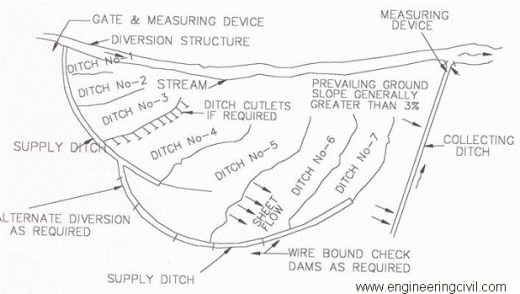
Figure 2: Ditch and Furrow Method
Lateral Ditch Pattern
The water from stream is diverted to the feeder canal/ ditch from which smaller ditches are made at right angles. The rate of flow of water from the feeder canal to these ditches is controlled by gate valves. The furrow depth is kept according to the topography and also with the aim that maximum wetted surface is available and uniform velocity can be maintained. The excess water is routed to the main stream through a return canal along with residual silt.
Dendritic Pattern
The water from stream is diverted from the main canal to a series of small ditches spread in adendritic pattern. The bifurcation of ditches continues until practically all the water is infiltrated in the ground.
Contour Pattern
The ditches are excavated following the ground surface contour of the area. When the ditch comes closer to the stream a switchback is made and thus the ditch is made to meander back and forth repeatedly. At a lowest point downstream, the ditch joins the main stream, thus returning the excess water to it.
Site Characteristics and Design Guidelines
(i) Although this method is adaptable to irregular terrain, the water contact area seldom exceeds 10 percent of the total recharge area.
(ii) Ditches should have slope to maintain flow velocity and minimum deposition of sediments.
(iii) Ditches should be shallow, flat-bottomed, and closely spaced to obtain maximum water contact area. Width of 0.3 to 1.8 m is typical.
(iv) A collecting ditch to convey the excess water back to the mainstream channel should be provided.
Ditch and furrow method is usually costly since it requires high level of supervision and maintenance.
2.2.1 MODIFICATION OF VILLAGE TANKS AS RECHARGE STRUCTURES
The existing village tanks, which are often silted up or damaged, can be modified to serve as recharge structure. In general no “Cut Off Trench” (COT) and Waste Weir is provided for village tanks. A village tanks can be converted into a recharge structure by desilting its bed and providing a COT on the upstream end of the bund. Several such tanks are available which can be modified for enhancing ground water recharge. Some of the tanks in Maharashtra and Karnataka have been converted.
2.2.2 PERCOLATION TANKS (PT)/ SPREADING BASIN
These are the most prevalent structures in India to recharge the ground water reservoir both in alluvial as well as hard rock formations. The efficacy and feasibility of these structures is more in hard rock formation where the rocks are highly fractured and weathered. In the States of Maharashtra, Andhra Pradesh, Madhya Pradesh, Karnataka and Gujarat, the percolation tanks have been constructed in basaltic lava flows and crystalline rocks. The percolation tanks are however also feasible in mountain fronts occupied by talus scree deposits. These are found to be very effective in Satpura Mountain front area in Maharashtra. The percolation tanks can also be constructed in the Bhabar zone. Percolation tanks with wells and shafts are also constructed to recharge deeper aquifers where shallow or superficial formations are highly impermeable or clayey.
2.3 RECHARGE OF DUG WELLS AND HAND PUMPS
In alluvial as well as hard rock areas, there are thousands of dug wells, which have either gone dry, or the water levels have declined considerably. These dug wells can be used as structures to recharge the ground water reservoir .Storm water, tank water, canal water etc. can be diverted into these structures to directly recharge the dried aquifer. By doing so the soil moisture losses during the normal process of artificial recharge, are reduced. The recharge water is guided through a pipe to the bottom of well, below the water level to avoid scouring of bottom and entrapment of air bubbles in the aquifer. The quality of source water including the silt content should be such that the quality of ground water reservoir is not deteriorated. Schematic diagrams of dug well recharge are given in Figure . In urban and rural areas, the roof top rainwater can be conserved and used for recharge of ground water. This approach requires connecting the outlet pipe from rooftop to divert the water to either existing wells/ tubewells/ borewells or specially designed wells. The urban housing complexes or institutional buildings having large roof areas can be utilised for harvesting roof top rainwater for recharge purposes (Figure).
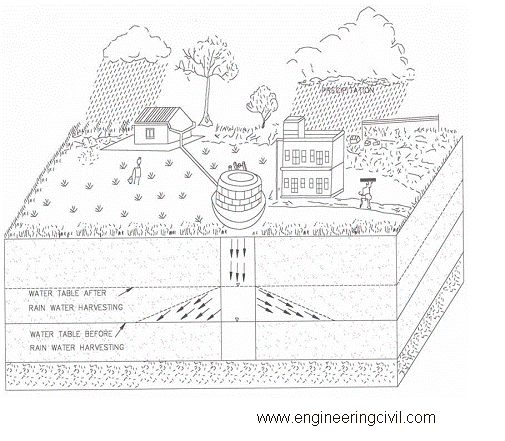
Recharge of Dug Wells through Roof Top Rain Water Harvesting (Figure 3).
2.4 RECHARGE SHAFT
These are the most efficient and cost effective structures to recharge the aquifer directly. These can be constructed in areas where source of water is available either for some time or perennially. Following are the site characteristics and design guidelines:
(i) To be dug manually if the strata is of non-caving nature.
(ii) If the strata is caving, proper permeable lining in the form of open work, boulder lining should be provided.
(iii) The diameter of shaft should normally be more than 2 m to accommodate more water and to avoid eddies in the well.
(iv) In the areas where source water is having silt, the shaft should be filled with boulder, gravel and sand to form an inverted filter. The upper-most sandy layer has to be removed and cleaned periodically. A filter should also be provided before the source water enters the shaft.
(v) When water is put into the recharge shaft directly through pipes, air bubbles are also sucked into the shaft through the pipe, which can choke the aquifer. The injection pipe should therefore be lowered below the water level.
The main advantages of this technique are as follows:
- It does not require acquisition of large piece of land as in case of percolation tanks.
- There are practically no losses of water in the form of soil moisture and evaporation, which normally occur when the source water has to traverse the vadose zone.
- Disused or even operational dugwells can be converted into recharge shafts, which does not involve additional investment for recharge structure.
- Technology and design of the recharge shaft is simple and can be applied even where base flow is available for a limited period.
- The recharge is fast and immediately delivers the benefit. In highly permeable formations, the recharge shafts are comparable to percolation tanks. The recharge shafts can be constructed in two different ways viz. vertical and lateral. The details of each are given in the following paragraphs.
2.4.1 VERTICAL RECHARGE SHAFT
The vertical recharge shaft can be provided with or without injection well at the bottom of the shaft.
Without Injection well
- Ideally suited for deep water levels (up to 15 m bgl).
- Presence of clay is encountered within 15 m.
- Effective in the areas of less vertical natural recharge.
- Copious water available can be effectively recharged.
- Effective with silt water also (using inverted filter consisting of layers of sand, graveland boulder).
- Depth and diameter depends upon the depth of aquifer and volume of water to be recharged.
- The rate of recharge depends on the aquifer material and silt content in the water.
- The rate of recharge with inverted filter ranges from 7-14 lps for 2-3 m diameter.
This type of shaft has been constructed at the following places and is shown in Figure.
- BrahmSarovar, Kurukshetra district, Haryana – silt free water
- Dhuri drain, Sangrur district, Punjab – surface runoff with heavy silt
- Dhuri link drain, Sangrur district, Punjab – surface runoff with heavy silt
- President Estate, New Delhi – roof top and surface runoff
- Nurmahal block, Jalandhar district, Punjab
- Kirmich and Samastipur, Kurukshetra district – surface water from depression
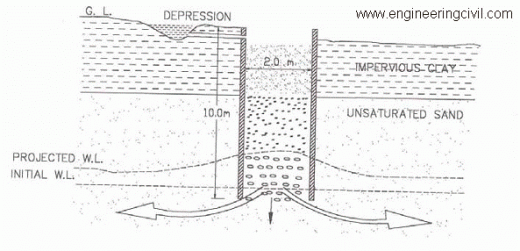
Figure 4 : Vertical Recharge Shaft Without Injection Well
2.5 With Injection Well
In this technique an injection well of 100-150 mm diameter is constructed at the bottom of the shaft piercing through the layers of impermeable horizon to the potential aquifers to be reached about 3 to l5 m below the water level (Figure).
- Ideally suitable for very deep water level (more than 15 m)
- Aquifer is overlain by impervious thick clay beds
- Injection well can be with or without assembly
- The injection well with assembly should have screen in the potential aquifer at least 3-5 m below the water level
- The injection well without assembly is filled with gravel to provide hydraulic continuity so that water is directly recharged into the aquifer
- The injection well without assembly is very cost effective
- Depending upon volume of water to be injected, number of injection wells, can beincreased to enhance the recharge rate
- The efficiency is very high and rate of recharge goes even up to 15 lps at certainplaces
These structures have been constructed at following places:
Injection Well Without Assembly
– Dhuri drain, Sangrur district, Punjab
– Issru, Khanna block, Ludhiana district, Punjab
– Lodi Garden, New Delhi
– Dhaneta, Samana block, Patiala district, Punjab
Injection Well With Assembly
– Dhuri drain, Sangrur district, Punjab
– Dhuri link drain, Sangrur district, Punjab
– Kalasinghian, Jalandhar district, Punjab
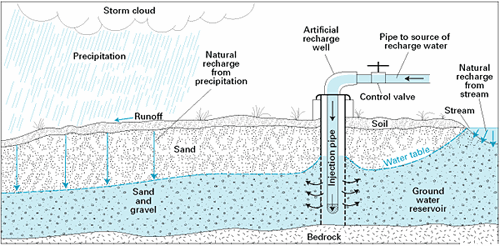
Figure 5 :Vertical Recharge Shaft With Injection Well
2.6 LATERAL RECHARGE SHAFT
- Ideally suited for areas where permeable sandy horizon is within 3 m below ground level and continues upto the water level – under unconfined conditions (Figure).
- Copious water available can be easily recharged due to large storage and recharge potential
- Silt water can be easily recharged
- 2 to 3 m wide and 2 to 3 m deep trench is excavated, length of which depends on the volume of water to be handled
- With and without injection well
This structure has been constructed at following places:
- Dhuri drain, Sangrur district, Punjab – 300 m (with 6 injection wells)
- Dhuri link drain, Sangrur district, Punjab – 250 m (with 3 injection wells)
- GarhiKangran, Baghpat district, U.P. – 15 m (with 2 injection wells)
- Shram Shakti Bhawan, New Delhi – 15 m (3 lateral shafts with 2 injection well in each)
- Dhaneta, Samana block, Patiala district, Punjab – 4 lateral shafts with injection wells
- D.C. Office Complex, Faridabad, Haryana – with injection wells
- Lodhi Garden, New Delhi – with injection wells
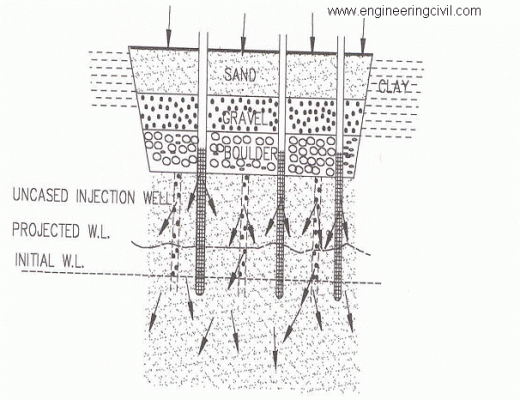
Figure 6: Lateral Recharge Shaft
2.7 Injection Method
Water is led directly into the depleted aquifers by providing a conduit access, such as tube well or shaft or connector wells. Recharge by injection is the only method for artificial recharge of confined aquifers or deep-seated aquifers with poorly permeable overburden. The recharge is instantaneous and there are no transit and evaporation losses. Injection method is also very effective in case of highly fractured hard rocks and karstic limestones but very high permeabilities are not suitable, as they do not allow the water to be retained for long periods for use during dry season. However, it is necessary to ensure purity of the source water as well as its compatibility with aquifer to prevent frequent clogging of injection structures, by bacterial growth, chemical precipitation or deposition of silt. Dual-purpose injection wells i.e. injection cum pumping wells are more efficient. Connector injection well where saturated shallow aquifer and over-exploited confined aquifers are tapped in a single well, allows free fall of water from shallow aquifer into the deeper aquifer, thereby reducing cost of injection. Injection method is also used as a “Pressure Barrier Technique” to arrest or reverse saline water ingression.
The selection of site for these structures depends upon the configuration of the confined aquifers, hydraulic gradient and location of source of surplus surface water. It is always better to construct it closer to source to save cost of water conveyance. This technique was successfully adopted at temple town of Bhadra challam in Andhra Pradesh during 1987 to provide safe drinking water to about 2 to 3 lakh pilgrims on the festival of Shriramanawami. The ground water aquifer had meager reserve and had to be necessarily replenished through induced recharge from Godavari river. The surface water could not be directly pumped to the distribution system due to turbidity and bacteriological contaminations. A water supply scheme was successfully executed by construction of 30 filter point wells of 90 cm diameter which yielded about 60 cum/ha of potable water, mainly the induced recharge from river with phreatic alluvial aquifer acting as filtering medium.
Hydraulically, the effectiveness of induction of water in injection well is determined by:
- Pumping rate
- Permeability of aquifer
- Distance from stream
- Natural ground water gradient
- Type of well
In alluvial areas injection well can be provided for recharging a single aquifer or multiple aquifers. An injection pipe with opening against the aquifer to be recharged may be sufficient. However, in case of number of permeable zones separated by impervious rocks, a properly designed injection well with inlet pipe against each aquifer to be recharged need to be constructed. The injection wells as means of artificial recharge are comparatively costlier and require specialized techniques of tubewell construction. Proper operation and maintenance are necessary to project the recharge well from clogging.
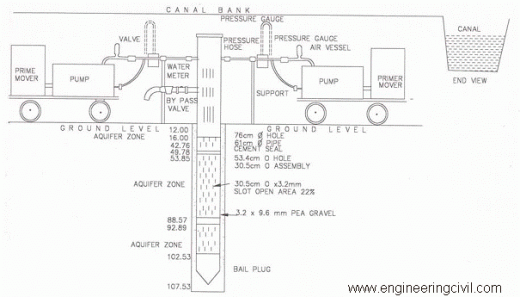
Figure 7: Artificial Recharge through Injection Well
2.8 INDUCED RECHARGE
It is an indirect method of artificial recharge involving pumping from aquifer, hydraulically connected with surface water, to induce recharge to the ground water reservoir. When the cone of depression intercepts river recharge boundary a hydraulic connection gets established with surface source, which starts providing part of the pumpage yield. In such methods, there is actually no artificial build up of ground water storage but only passage of surface water to the pump through an aquifer. In this sense, it is more a pumpage augmentation rather than artificial recharge measure.
In hard rock areas the abandoned channels often provide good sites for induced recharge. Check weir in stream channel, at location up stream of the channel bifurcation, can help in high infiltration from surface reservoir to the abandoned channel when heavy pumping is carried out in wells located in the buried channel. The greatest advantage of this method is that under favourable hydrogeological situations the quality of surface water generally improves due to its path through the aquifer material before it is discharged from the pumping well. For obtaining very large water supplies from riverbed, lake bed deposits or waterlogged areas, collector wells are constructed. In India such wells have been installed in Yamuna bed at Delhi and other places in Gujarat, Tamil Nadu and Orissa. The large discharges and lower lift heads make these wells economical even if initial capital cost is higher as compared to tube well.
3.0 MONITORING MECHANISM FOR ARTIFICIAL RECHARGE PROJECTS
The monitoring of water levels and water quality is of prime importance in anyscheme of artificial recharge of Ground Water. The monitoring data speaks for theefficacy of structures constructed for artificial recharge and greatly helps in takingeffective measures for Ground WaterManagement on scientific lines.
3.1 Water Level Monitoring
During the feasibility study stage the monitoring of surface water and groundwater levels greatly help in identifying the method of artificial recharge. Net work of observation wells is used to study the ground water flow pattern and temporal changes in potentiometric head in the aquifer.The observation well net work during feasibility stage is generally of low well density but spread over a large area with the primary aim of defining the boundary zonation of the aquifer to be recharged and to know the hydraulic characteristics of the natural ground water system. After identification of the feasible groundwater structure the observation well net work is redefined in a smaller area with greater well density. The objective of monitoring system is to study the effect of artificial recharge on the natural ground water system. Depending on the method of artificial recharge and the hydrogeology of the area, the observation well net work has to be designed. The monitoring system of observation well network should be designed specially to monitor impact of individual structures which can further be extended to monitor the impact of group of such structures in the artificial recharge scheme area. The network should contain observation wells (1) near the center of the recharge facility (2) a sufficient distance from the recharge facility to observe composite effects and (3) near the limit of hydrological boundaries. If the recharged aquifer is overlain by confining/semi-confining layer, piezometers should be installed to monitor the water levels of overlying and underlying aquifers which helps in the study of leakages etc.
Where the surface water bodies are hydraulically connected with the groundwater aquifer which is being recharged, it is advisable to monitor the water level profiles of both Surface water and Ground water.
The periodic monitoring of Water Levels can demarcate the zone of benefit. In this method a network of observation wells is established in the area likely to be benefited and following observations are made:
1. In the zone benefited, the water levels be observed to the whether the well hydrographs have a flat apex during the time when there is water in the recharge structure (tank, pit etc.).
2. Wells situated outside the zone of influence normally show an angular apex for the period when the recharge is taking place, while these situated within the zone of influence have a flatter area.
3. The recession limbs of wells close to a recharge structure normally have a gentle gradient as compared to those located far off.
4. Crops in the zone of influence will be healthy compared to those outside such an area. Further more, in the zone of influence there is a tendency to grow crops with high water requirements.
5. Well yields in the zone of influence should be greater than those outside it. The wells in benefited zones may have more sustainability in lean period than those outside.The above criteria can be used to define the zone of influence and thereby, a real and temporal demarcation of the effectiveness of recharge structures. This methodology was adopted in Maharashtra, India.
3.2 Water Quality Monitoring
The monitoring of water quality during the implementation of artificial recharge schemes is essential to maintain the quality standards for specified uses of the augmented resource. In case of injection wells the composition of native water in the aquifer and the recharged water is important to prevent clogging of well and aquifer due to excessive precipitation of salts. The data on the chemical quality of native water and the changes which take place during the artificial recharge schemes should be collected by regular sampling from observation well net work. Where treated wastewater is used for recharges careful monitoring is required to detect and preclude any possibility of contamination through a network of monitoring wells. Thus, the type of water quality monitoring programme depends on the specific problem being studied i.e. changes in ground water quality, effect of soil salination, and prevention of any contamination etc. The samples to be collected will also depend on the purpose and are generally categorised into (1)Indicative (2) Basic and (3) Comprehensive. The indicative samples are collected at 1 to4months intervals and used to ascertain the presence of injected effluent. Basic samples are taken at monthly intervals for wells already influenced by recharge to determine the effect of recharge effluent on ground water quality and the purification provided by flow through the soil and aquifer system. Comprehensive samples are taken at intervals of 6 months to1 year for observation wells and production wells to determine water quality with respect to specific standards for intended water use.
Impact Assessment
The impact assessment of Artificial Recharge schemes can generally be enumerated as follows: –
a) Conservation and harvesting of surplus monsoon runoff in ground water reservoir which otherwise was going un-utilised outside the watershed/ basin and to sea.
b) Rise in ground water levels due to additional recharge to ground water. In case where continuous decline of ground water level was taking place, a check to this and/or the intensity of decline subsequently reduces. The energy consumption for lifting the water also reduces.
c) The ground water structures in the benefitted zone of artificial structures gains sustainability and the wells provides water in lean month when these were going dry. The domestic wells will become sustainable and many of the areas become tanker free.
d) The cropping pattern in the benefitted zone will undergo marked change due to additionality of ground water and cash crops will start growing. Orchards which went dry earlier due to ground water scarcity may rehabilitated and new plantation be grown.
e) Green vegetation cover may increase in the zone of benefit and also along the structures due to additional availability of soil moisture.
f) The quality of ground water may improve due to dilution.
g) Besides the direct measurable impacts, the artificial recharge schemes will generate indirect benefit in terms of decease in soil erosion, improvement in fauna and flora, influx of migratory birds, etc.
Besides, the social and economic status of farmers of benefitted zone will also substantially improve due to increase in crop production.
4.0 CASE HISTORIES OF ARTIFICIAL RECHARGE IN MAHARASHTRA
The artificial Recharge for augmentation of ground water reservoir and to provide sustainability to ground water development. The schemes for artificial recharge are being implemented in different hydrogeological situations. The case histories in Indian context are given herein under:
4.1 Artificial Recharge For Ground Water Sustainability In Basaltic Terrain –
Maharashtra:
The Central Ground Water Board has conducted specific studies in an over exploited watershed WR-2, Amravati district, Maharashtra. where excessive development of ground water to meet the crop requirements for orange cultivation has depleted the ground water resources. The receding ground water levels in this watershed have resulted in increased lifting costs for ground water withdrawal, deepening of wells,construction of deep bore wells and in many cases reduction in areas as well as production of orange crops. The multidisciplinary approach adopted by Central Ground Water Board to augment sub-surface storage included topographical studies to assess and understand various physiographic parameters important to locate the appropriate recharge structures, Hydrometeorological studies to assess the rainfall pattern for working out design of recharge structures, hydrological studies to assess non committed surplus monsoon run off available for recharge and hydrogeological studies to assess the capability of basaltic aquifers to accommodate the additional recharge for utilization in lean period. The studies have brought out that the watershed covering 488 sq.km. area has surplus monsoon runoff of about 98.9 Million Cubic Metres (MCM) which can be conserved through simple artificial recharge structures like percolation tanks and check dams (cement plugs).The efficiency of these structures constructed at suitable locations with appropriate design in case of percolation tanks is 91% and for cement plugs 94%. The total capacity utilization of percolation tank has been found to be upto 150%due to repetitive fittings and up to 400% in case of cement plugs. The benefited area in case of percolation tanks with gross storage capacity varying from 71 to 220 Thousand Cubic Metres (TCM) varied from 60 to 120 hectares (ha) during 1997-98 and benefits extended upto 1.5 km. down stream of percolation tanks. In case of cement plugs with storage capacity varying from 2.10 TCM to 7.42 TCM varied from 3 to 15 ha during 1997-98. The existing dug wells in the command areas of these structures were benefited not only in terms of rise in ground water levels compared to pre-project period but the sustainability of ground water pumpage increased during summer period. The Figures 14 and 15 indicate the improvement in ground water levels in the command areas of percolation tank and Check dam. Additional areas were brought under cultivation and areas of orange orchards have increased. The project implemented by CGWB has proved the techno-economic feasibility of the artificial recharge techniques in basaltic terrain with no adverse environmental impact.
4.2 Mountain Front Recharge Augmentation For Alluvial Aquifers -Maharashtra:
The prominent regional aquifer system for Tapi Alluvial basin paralleling Satpura Mountain front is being extensively developed to meet the water requirement of cash crops like Banana and Sugarcane. This has led to decline of water levels of more than 8-10 metres during last 10-15 years. Large number of wells has either gone dry or their yields have declined. There is thus an urgent need to augment the ground water resources of the Tapi alluvial basin. The Satpura Mountain front offers favourable locale to augment ground water reservoir due to the high infiltration capacity of alluvial fans occurring in this zone. The Central Ground Water Board has undertaken artificial recharge studies in one of the watersheds TE-17 in Jalgaon district wherein extensive ground water irrigation for Banana crop has resulted in depletion of ground water resource. The studies undertaken included assessment of surplus monsoon run off available in the watershed and delineation of potential talus and scree zone locally known as Bazada which offers favourable location for construction of artificial recharge structures. The studies included assessment of the total thickness of unsaturated granular zone above water table to determine the potential of recharge in this zone. The subsurface storage potential of watershed 5 metres below ground level was assessed as 85Million Cubic Metres (MCM) compared to surplus monsoon runoff of 29.7 MCM.Artificial recharge techniques like recharge through percolation tanks, recharge through existing dug wells, recharge shafts and through injection tubewells were experimented.Some of the existing artificial recharge structures like village tanks were renovated to convert these into percolation tanks and storage capacity of existing percolation tanks was augmented by stream diversion from adjacent watershed. The percolation tanks in Bazada formation of Satpura foothills were found to be highly efficient with efficiency as high as97% and capacity utilisation going upto 400%. The zone of benefit extended to 5 km with benefited area up to 400 ha. The recharge through existing disused dug wells utilizing surplus water from existing canal irrigation system provided encouraging results and after observing this experiment, the local farmers have resorted to dug well recharge through their own efforts providing sustainability to ground water development. Recharge through injection tubewell though feasible is not very effective and efficient compared to other artificial recharge techniques. The studies undertaken by Central Ground Water Board have clearly indicated that the Satpura Mountain front is quite favourable for implementation of a mega artificial recharge project which can utilize the techniques experimented in watershed TE-17 for augmenting the depleting ground water resources of Tapi Alluvial Tract.
4.3. Artificial Recharge In Urban Areas, Nagpur, Maharashtra
Considering the overall physiographic, hydrogeological, hydrological, demographic and socio-cultural set up of the Nagpur Metropolitan Region, following schemes are feasible for ground water augmentations.
a. Roof top rainwater harvesting.
b. Run off rainwater conservation.
c. Recharge through percolation tanks and check dams.
The first two schemes are feasible for the densely populated pockets of the city area underlain by basaltic terrain, where land availability for construction of surface reservoir is non-existent. The third scheme of construction of percolation tanks and check dam is feasible for the peripheral and outskirts region which are rural areas with plenty of open space available.
4.3.1 Roof top rainwater harvesting for ground water recharge
In Nagpur city roof top rain water experiment was done in Ujjwal Nagar area where the roof top rain water collected from the concrete roof of 100 m3 was diverted into the existing water supply dug well of the house hold. About 80,000 litres was recharged during the monsoon.
4.3.2 Run off rain water harvesting for ground water recharge in city area
The rainfall runoff flowing from the roads and open grounds is substantial during the monsoon. This water often creates the water logging and the drainage system is put under stress in the urban agglomerates. This ultimately flows out of the city unutilised. This water if conserved and utilized properly for recharging the ground water reservoir may bring much needed relief to the water scarcity areas of the city. One such scheme has been prepared by the Central Ground Water Board for Ujjwal Nagar of Nagpur. The design and plan of the scheme is presented in Fig.-20. In this scheme about 15000 sq.m. of catchment is intercepted where run off generated would be diverted in the purpose built recharge well in the public garden. The run off water is filtered silt free by providing a filter pit. The scheme has made impact in the wells near the recharge well and water levels in the wells have risen.
5.0 PROBLEMS IN ARTIFICIAL RECHARGE
1. Recharge rate generally decreases as the main particle size of soil on a spreading area decreases.
2. Alternating wet and dry periods on a basin generally furnishes a greater total recharge then does continuous spreading in spite of the fact that water is in contact with the soil for as little as one half of the total time.
3. Studies in small ponds have confirmed that infiltration rates are directly proportional to head of water where less pervious strata lie below the surface strata, the recharge rate depends on the rate of subsurface lateral flow. Hence, spreading only in narrow, widely spaced strips recharges nearly as much water as spreading over an entire area.
4. Water containing silt or clay is known to clog soil pores, leading to rapid reductions in recharge rates.
5. Wave action in large, shallow ponds can stir bottom sediments and seal pores that would otherwise remain open.
6. Water quality can be an important factor, thus recharging water to high sodium content tends to defloculate colloidal soil particles and thereby hinder water passage.
5.1 PRECAUTIONS TO BE TAKEN IN ARTIFICIAL RECHARGE
A detail study of environmental aspects of water spreading by Nightingale and Bianchi at Fresho, California shows following precautions to maximize infiltration rates in basins.
1) Soil for levees should be brought from a borrow pit, and heavy construction equipment should be kept out of basins.
2) Recharge water should be introduced at its lowest point to prevent intra-basin erosion and clogging of the soil surface.
3) Trees and shrubs should be removed initially and the soil disked once.
4) Turbid water should be prevented from entering basins.
5) Aquatic vegetation should be minimized to prevent biological clogging of soils.
6) Recharge should be concentrated in summer when basin water temperature is highest.
6.0 Conclusions
Artificial recharge of groundwater is expected to increase\ worldwide as populations rise. Factors affecting the availability of water resources include increasing demands for water while water resources remain finite; potential climate changes; lack of availability of good dam sites for surface storage; and increasing difficulty of building dams because of social, environmental, costs, and other objections. Also, dams are not effective for long-term storage of water because of evaporation losses. Artificial recharge, resulting in conjunctive use of surface water and groundwater and long-term underground storage or water banking, is preferred where possible. Artificial recharge also plays an important role in water reuse, because it gives quality benefits (soil-aquifer treatment) and storage opportunities to absorb seasonal differences between supply and demand for reclaimed sewage effluent. Where sewage effluent is used for potable purposes, recharge and recovery breaks the objectionable toilet-to-tap connection of water reuse and enables blending with natural groundwater. This enhances the aesthetics and public acceptance of potable-water reuse. Water reuse and storage of surplus water for use in times of water shortage also must be increasingly relied upon to cope with future uncertainties in climates and their effect on surface and groundwater supplies. Design and management of artificial recharge systems involves geological, geochemical, hydrological, biological, and engineering aspects. Because soils and underground formations are inherently heterogeneous, planning, design, and construction of groundwater recharge schemes must be piecemeal, first testing for fatal flaws and general feasibility and then proceeding with pilot and small-scale systems until the complete system can be designed and constructed. This approach is especially valid for large systems, where scale effects are usually very significant and large amounts of money are commonly involved.
References:
1.Guide on Artificial Recharge of Ground WaterNew Delhi May, 2000.
2. Manual on Artificial Recharge of Ground Water.
3. National Drinking Water Mission and Department of Rural Development 1989. Rain Water Harvesting. Government of India, New Delhi.
4. David Keith Todd., “Ground Water Hydrology”, 2nd edition, John Wiley & Sons publication.
We at engineeringcivil.com are thankful to Er Shubham Sunil Malu for submitting this very useful paper to us. We are sure this would be of great help to all engineers seeing more information on Artificial Recharge of Groundwater.
If you have a query, you can ask a question here.



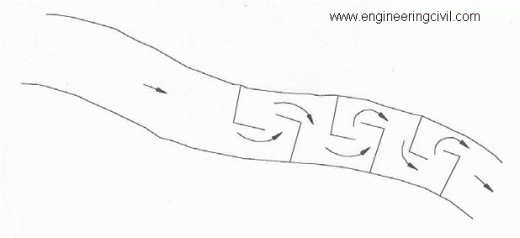
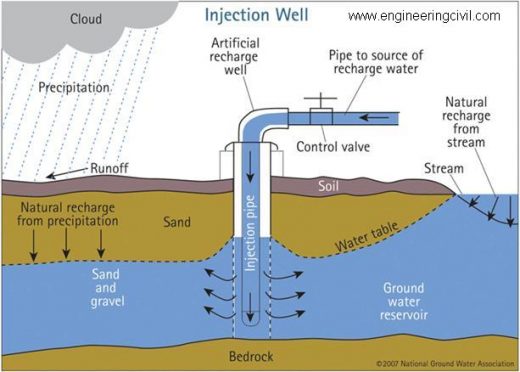
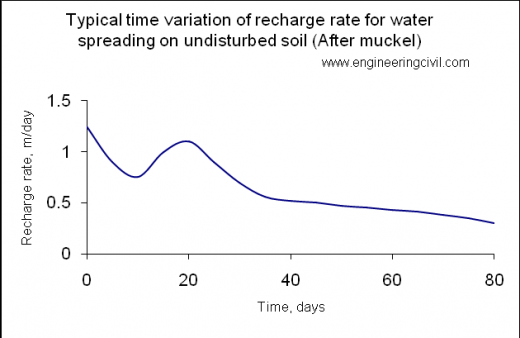
Is injection method is useful for increase the groundwater table in cities
Good day Ma’am/Sir, I would like to ask the particular publishing year of this research.Thanks alot
what is the required velocity of water flow in ditch and furrow method?